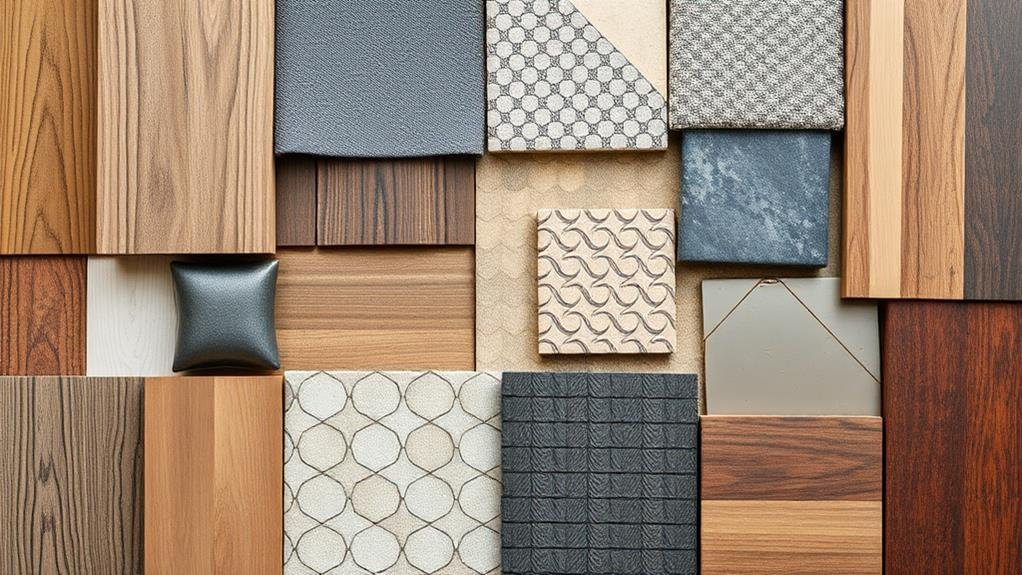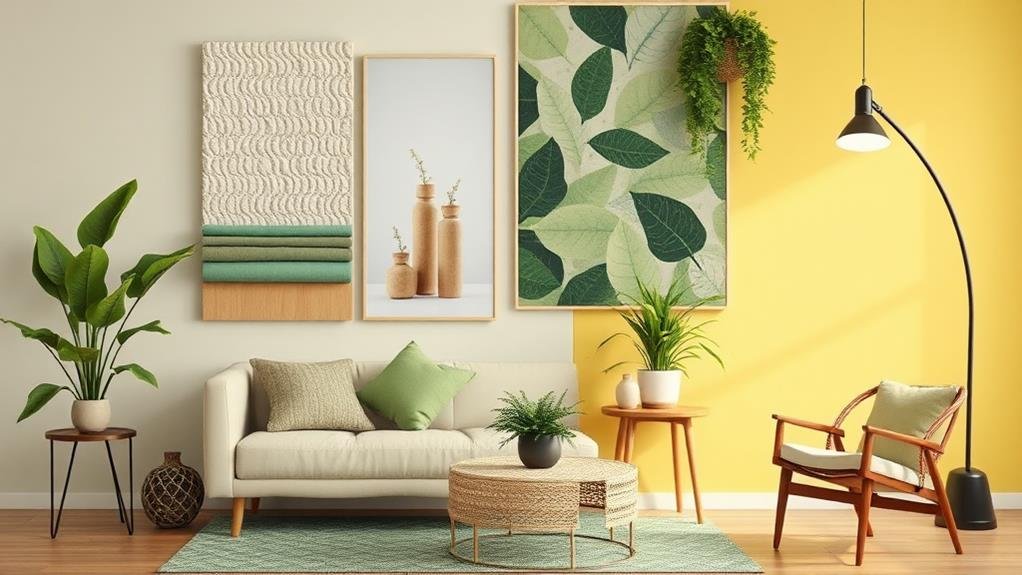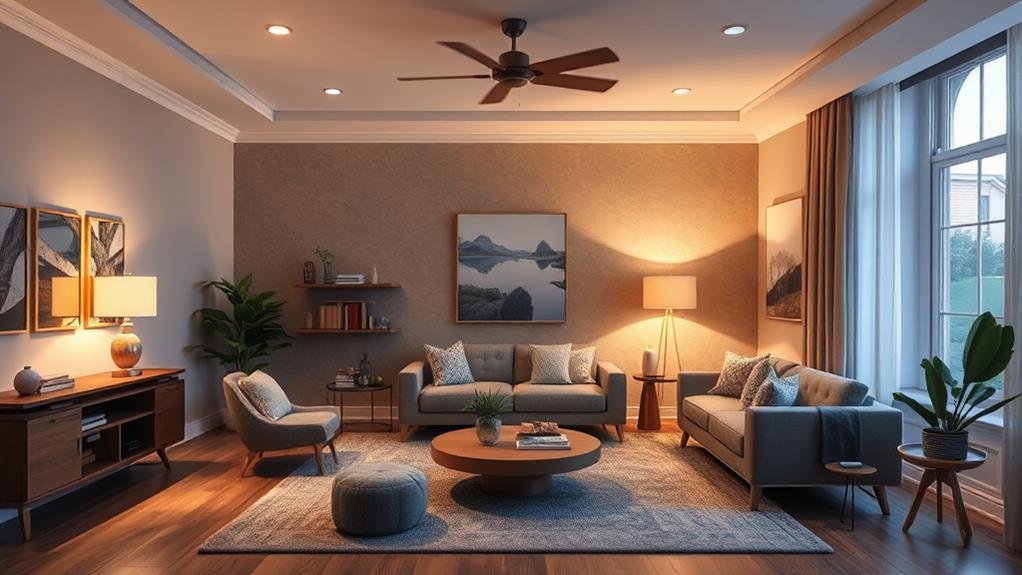Before diving into your interior design project, ensure you carefully budget, considering costs, funding sources, and potential contingencies for a stress-free journey. Your style preferences should reflect your unique tastes, harmonizing current trends with your comfort needs and personal aesthetic. Assess your space meticulously, ensuring optimal traffic flow and ergonomic design choices. Consider functional needs, incorporating multi-functional furniture and efficient storage solutions. Plan your timeline wisely, setting clear objectives and allowing for flexibility. And if you want to learn more about hiring professionals, material selection, project management, and sustainable practices, the key to a successful project lies in these essential considerations.
Key Takeaways
- Establish budget limits to guide financial decisions effectively.
- Define style preferences to align design with personal taste.
- Evaluate space dimensions for efficient layout planning.
- Prioritize functionality to enhance usability and comfort.
- Create a timeline with milestones for organized project management.
Budgeting

When embarking on an interior design project, one of the vital elements to consider is budgeting. Cost estimation is the first step in ensuring your project stays within financial boundaries.
Research funding sources to find the best fit for your needs. Keeping meticulous track of expenses is crucial for effective budget management.
Implementing contingency planning allows for unforeseen costs, providing a safety net for unexpected expenditures. It's important to assess the value of each expenditure to determine its impact on the overall design and budget.
Financial flexibility is key; having room for adjustments can prevent stress and allow for creativity to flourish within set financial constraints.
Style Preferences

Defined by a unique interplay of personal tastes and design principles, your Style Preferences are the cornerstone of any successful interior design project.
When considering your design aesthetics, think about how historical influences and cultural elements resonate with you. Are you drawn to the sleek lines of modern design, or perhaps the intricate details of a Victorian era?
Being aware of current trends can also guide your choices, ensuring your space feels current yet timeless.
Comfort factors play a crucial role in creating a space that truly feels like home.
Think about how different materials can impact the overall ambiance and functionality of a room. Do you prefer the warmth of wood or the contemporary feel of metal?
Your material preferences can greatly influence the visual appeal of your space.
When selecting furniture and decor, remember to balance style with comfort, creating a harmonious environment that reflects your unique personality.
Space Assessment

Before embarking on your interior design journey, a crucial step is to assess the space you'll be transforming. Start by analyzing the space dimensions to understand the layout and plan accordingly.
Consider the traffic flow within the room so that the design enhances movement and usability. Pay attention to ergonomic design principles to ensure comfort and practicality. Accurate measurements are paramount to avoid any design mishaps.
Additionally, assess spatial relationships between key elements to create a harmonious atmosphere. Take into account the user experience throughout the space, keeping functionality at the forefront.
Observe architectural features such as windows, doors, and structural elements that could influence the design direction. Understand any design constraints present in the space, such as fixed furniture or limited lighting options.
Functional Needs

When considering the functional needs of a space, you should prioritize space optimization and practical layouts.
Think about how to make the most out of every corner and how to ensure that the flow of the room is efficient and purposeful.
Space Optimization
To make the most of your interior design project, it's essential to focus on space optimization, particularly when it comes to addressing functional needs.
When considering space efficiency, think about using multi-functional furniture pieces that can serve dual purposes, such as a storage ottoman or a sofa bed. Utilizing vertical storage options can help maximize floor space, while zoning techniques can create designated areas for different activities within an open layout.
Area rugs can define spaces and add warmth, contributing to flow optimization throughout the room.
Remember that decluttering strategies are crucial in maintaining a sense of spaciousness, ensuring that each item has a designated place. Pay attention to room proportions to create a balanced environment, and incorporate ergonomic design for comfort and practicality.
Practical Layout
Creating a practical layout that accommodates your functional needs is the cornerstone of a successful interior design project. When designing the layout of a room, consider the furniture flow – ensure there's enough space for movement and that the placement of furniture is both aesthetically pleasing and functional.
Start by identifying the primary function of the space and then strategically place furniture to support that purpose. Room zoning is also vital to create distinct areas within a room for different activities.
For example, in a living room, you could have a seating area for socializing, a reading nook for relaxation, and a workspace for productivity. By defining these zones, you can make the most of the available space and ensure each area serves its intended function effectively.
Timeline Planning

Embarking on an interior design project demands strategic planning to ensure a smooth and efficient process.
When it comes to timeline planning, it's crucial to set clear objectives and milestones to stay on track. Here are a few key considerations to keep in mind:
- Project Milestones: Break down the project into smaller, more manageable milestones to track progress effectively.
- Schedule Flexibility: Allow room for unexpected delays by incorporating flexibility into your timeline. This helps accommodate any unforeseen challenges that may arise during the project.
- Regular Check-Ins: Schedule regular check-in points to assess the project's progress against the timeline. This allows you to make proactive adjustments if needed, ensuring deadlines are met efficiently.
Color Scheme Selection

Ready to transform your space?
When selecting a color scheme, consider harmonizing with hues that flow seamlessly throughout the room, creating a sense of unity.
Mood-setting palettes can evoke feelings of serenity, energy, or coziness, setting the tone for your interior design project.
Harmonizing With Hues
Navigating the vast world of color schemes can be both exhilarating and daunting as you embark on transforming a space.
Selecting the right hues to harmonize within your interior design project is crucial. Each color carries its own psychology, influencing the emotional impact of a room significantly.
Here are some key considerations to keep in mind as you dive into the world of harmonizing hues:
- Color Wheel Exploration: Delve into the color wheel to understand complementary, analogous, and monochromatic schemes. This exploration will guide you in creating cohesive color combinations that evoke the desired mood.
- Natural Inspiration: Draw inspiration from nature's harmonious color palettes. Reflecting elements like serene blues of the ocean or earthy greens of a forest in your design can create a calming and balanced atmosphere.
- Testing and Sampling: Before committing to a color scheme, test different hues on the walls or with fabric samples. This hands-on approach will help you visualize how the colors interact in your space and ensure a harmonious result.
Mood-Setting Palettes
To set the mood right in your interior design project, careful selection of color schemes is paramount. Colors have a significant influence on mood and can evoke various emotional responses. Understanding color psychology can help create a space vibe that resonates with your desired ambiance.
Consider how different hues impact sensory experiences within a room, shaping the overall feel of the space. When choosing your color palette, strive for thematic coherence to ensure a harmonious flow throughout the design.
Incorporating seasonal trends can add a contemporary touch while allowing for personal expression within the space. Whether you opt for bold and vibrant tones or calming pastel shades, each color choice contributes to the atmosphere you wish to create.
Furniture Selection

With careful consideration and a keen eye for style, selecting the right furniture for your interior design project can truly transform a space into a personalized haven.
When choosing furniture, here are some key aspects to keep in mind:
- Furniture Trends: Stay updated on the latest styles and designs to ensure your space feels modern and fresh.
- Ergonomic Design: Prioritize comfort and functionality to create a welcoming environment that supports your well-being.
- Space Versatility: Opt for pieces that can adapt to different layouts and purposes, maximizing the potential of your space.
Incorporating statement pieces, modular solutions, eco-friendly options, custom builds, vintage finds, and multi-functional furniture will add character and depth to your design.
Strive for aesthetic balance by mixing textures, shapes, and colors harmoniously.
Lighting Considerations

As you embark on your interior design journey, lighting considerations play a crucial role in setting the mood and functionality of a space.
Choosing between natural and artificial light sources can greatly impact the ambiance and energy of a room.
Moreover, layering different lighting elements allows you to create depth, highlight focal points, and enhance the overall aesthetic appeal of your design.
Natural vs. Artificial
Why is the choice between natural and artificial lighting crucial in interior design projects?
Natural lighting brings the warmth of the sun into your space, creating a connection to the outdoors often associated with biophilic design principles. On the other hand, artificial lighting provides consistency and control in different light temperatures, ensuring energy efficiency through smart choices.
Selecting between these options can significantly impact the mood of your room, the flexibility of your design, and the overall cost implications.
- Mood Impacts: Natural light can uplift spirits and enhance productivity, while artificial lighting can be adjusted to create various atmospheres.
- Energy Efficiency: Artificial lighting can be optimized for energy savings, whereas natural light can reduce reliance on electricity during the day.
- Maintenance Considerations: While natural light is free, it can also lead to issues like glare and fading; artificial lighting may require regular bulb changes and upkeep.
Layering for Ambiance
Maximizing the ambiance in your space through strategic lighting layering is a fundamental aspect of interior design that can elevate the overall aesthetic and functionality of a room.
When considering lighting for ambiance, it's essential to think beyond just illumination. Think about how different lights can create texture contrast and visual layering, enhancing the sensory elements within the space.
By carefully managing sound and incorporating scent, you can further enrich the atmosphere. Additionally, don't forget about making seasonal adjustments to adapt to varying natural light levels throughout the year.
Infusing personal touches that reflect your unique style and cultural influences can truly make the ambiance feel authentic and inviting.
Whether you opt for warm, intimate lighting or bright, energizing lights, the key is to create a harmonious blend that complements the space.
Experiment with different lighting fixtures, intensities, and placements to find the perfect balance that suits your needs and enhances the ambiance of your space.
Hiring Professionals

In the dynamic world of interior design projects, navigating the process of hiring professionals can be pivotal to the success of your endeavor. When seeking experts to bring your design vision to life, consider the following key aspects:
- Designer Qualifications: Look for professionals with strong credentials and a portfolio that aligns with your style and expectations.
- Collaboration Strategies: Ensure the designer values your input and is open to a collaborative approach throughout the project.
- Project Communication: Establish clear channels of communication to keep all involved parties informed and aligned on the project's progress.
Choosing the right professional for your interior design project involves more than just their creative input.
Pay close attention to contract details, ensuring they reflect your client expectations and offer room for timeline flexibility.
A successful partnership with a skilled designer can make all the difference in creating a space that truly reflects your personality and style.
Material Selection

Material selection plays a crucial role in shaping the overall aesthetic and functionality of your interior design project. When choosing materials, consider sustainability by opting for eco-friendly choices that minimize environmental impact.
Explore a diverse range of textures to add depth and visual interest to your space. Durability should also be a key factor, ensuring your selections can withstand daily wear and tear. Evaluate various sourcing options to find the best quality materials for your budget, considering both cost implications and performance characteristics.
In addition to aesthetics, it's essential to think about material compatibility to create a cohesive look throughout your design. Understand the maintenance needs of different materials to make informed choices that align with your lifestyle.
Project Management

When embarking on an interior design project, how do you ensure that every aspect seamlessly comes together to bring your vision to life? Effective project management is the key to success. Here are some essential considerations:
- Scope Definition: Clearly outline the project's goals, deliverables, and limitations to ensure everyone is on the same page.
- Risk Management: Identify potential risks and develop strategies to mitigate them throughout the project.
- Team Collaboration: Foster open communication and collaboration among team members to leverage individual strengths and achieve synergistic outcomes.
Ensuring strong communication strategies, proper task prioritization, progress tracking, and client involvement are crucial.
Allocating resources efficiently, setting realistic deadlines, and implementing rigorous quality control measures are also fundamental to a successful interior design project.
Sustainability Factors

Considering sustainability factors in your interior design projects is no longer just a trend but a critical responsibility that shapes the future of design.
By incorporating eco-friendly materials and focusing on energy efficiency, you can create spaces that not only look good but also contribute positively to the environment. Choosing materials like reclaimed wood, bamboo, cork, or recycled metal can significantly reduce your project's carbon footprint and promote a more sustainable industry.
Additionally, investing in energy-efficient appliances, lighting, and HVAC systems can help lower energy consumption within the space. This not only benefits the environment but also leads to long-term cost savings for the occupants.
By prioritizing sustainability in your design choices, you can showcase how style and eco-consciousness can go hand in hand, setting a new standard for responsible interior design practices.
Conclusion
As you embark on your interior design journey, remember that just like a puzzle, every piece must fit together seamlessly for the final masterpiece to come to life. Be mindful of the intricate details, have patience as you navigate through the process, and trust in the vision you have for your space. Embrace the challenges as opportunities for growth and transformation, and soon you will see your dreams materializing before your eyes. Stay inspired and enjoy the journey.

